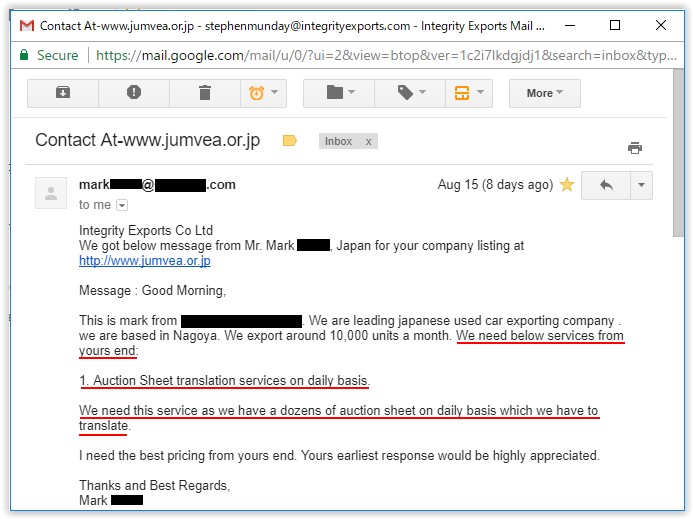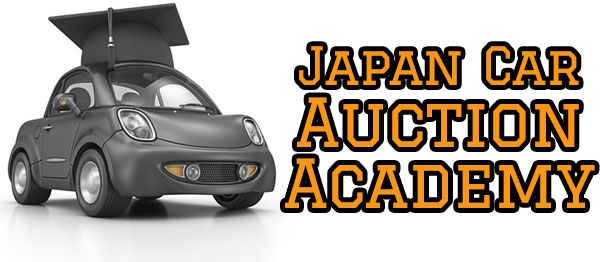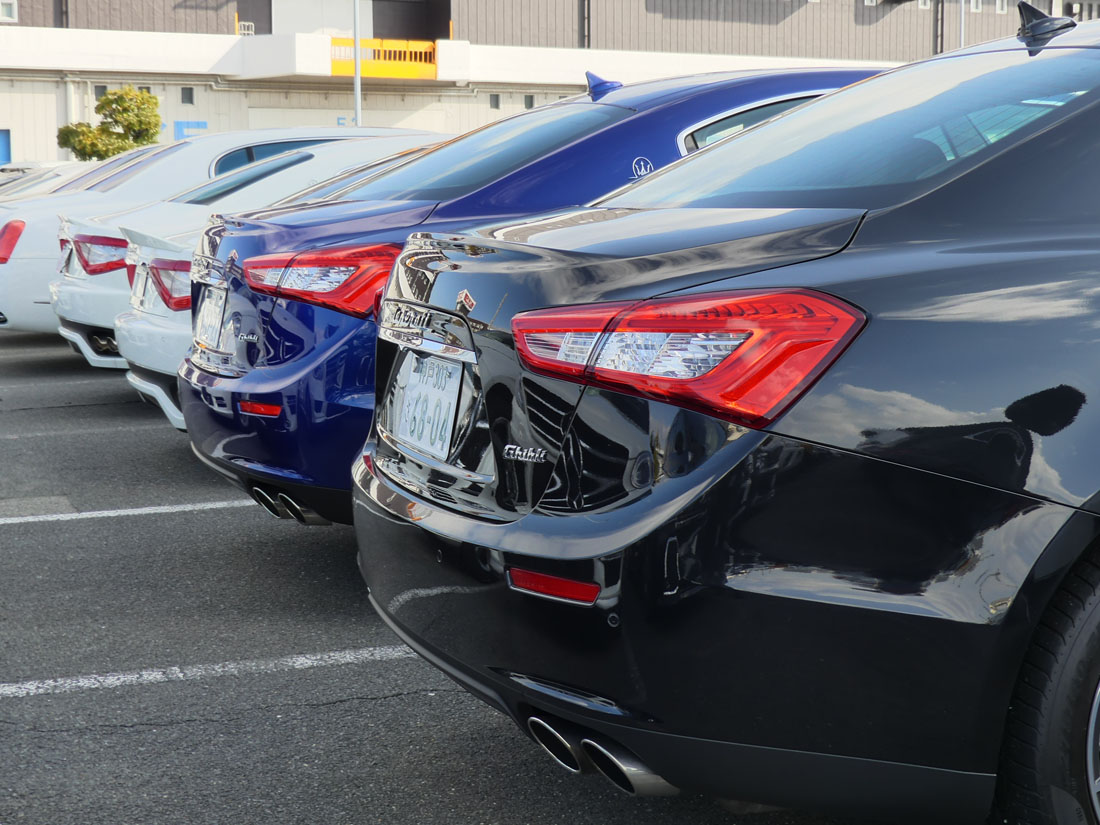What's the point of getting an auction sheet translation?
At Integrity Exports, it is our opinion that if a car is below grade 5, then it is important to make sure you get a translation of these remarks before you consider bidding on any vehicle.
The reason is simple: The auction grades are broad (especially grades 3.5 and 4 that make up about 50% of auctioned vehicles), and the lower the grade, the more likely it is that the vehicle may have some serious issues that could put you off bidding. You want to know exactly what you are getting before you make a bid.
Even when you are bidding on higher grade vehicles, such as grade 5, grade 6 etc., a translation is still going to be useful as you are likely to find out more about the sales points of the car, such as what equipment it has.
Why is a human translation better?
If you have ever used Google Translate, you will know that, while machines do pretty well considering that they cannot understand the content of what they are translating, a computer translation still is just not that great.
When you are making a decision about whether to buy a car and what your bidding budget should be, it is vital that you get a professional human translation. Just having a "rough idea" is not going to cut it.
All our translations are done by humans. Not just any old humans, either. We all have extensive academic training in Japanese, as well as in the art of translation. You can read more about our highly-qualified translation team here.
Integrity Exports offers translations to all customers who are bidding on cars with us for no extra charge. Yes, that's right. While some exporters will charge you 500 Yen per translation, whether you end up getting the car or not, we charge you nothing.
Why do we do it for free? Well, it is part of our goal: We want to make buying from car auctions in Japan “smooth and stress-free”. One of the keys to taking away your stress is ensuring you have all the information you need about the cars you might want to have a go at purchasing before you place a bid.
Our Competitors Love Our Auction Sheet Translations (But Can't Get Them!)
This email was not the first time a competitor contacted us to see if we would translate auction inspection reports for them too.
Of course, we refused, but it shows just highly our auction sheet translation services are rated by our competitors, not just our customers.

Unique Round-the-clock translation service
If you have ever bought cars from other exporters, you will probably remember how frustrating it is to have to wait for auction sheet translations until office hours start in Japan.
Depending on your time zone, this can result in severe sleep deprivation. Lack of sleep doesn't just ruin your day. It can also ruin your business, as making bidding decisions when tired and desperate to get to bed can result in disastrous mistakes.
This is why we have a translation team that is not only very highly qualified, but also based around the world. As far as we know, we are the only Japan-based car exporter to offer round-the-clock translations. While our competitors are asleep in Japan, our international translation team members in Spain and Slovenia take over to help get you translations at a time that is convenient for your timezone.
What is included in the translation?
When we enter a translation of the auction sheet, we do not literally translate all the information it contains. Some of it just isn't relevant. We wouldn't want that irrelevant information to distract you from the key points about the car.
First of all, some information, such as that about optional equipment like navigation systems or air conditioning, is already displayed on the page with the auction inspector’s report. Then there is other information that will not be important to you as a buyer outside of Japan. Examples of this are the cost of the recycle fee, or the date the roadworthiness test certificate (shaken in Japanese) expires – which the translator will skip over.
The translator will, however, make sure that you get all the positive and negative points about the vehicle which are going to be important to you as an overseas buyer. This information is translated into clear English by a native or totally bilingual speaker of English who is also fluent in the Japanese language.
As we translate, we will also take into account the market for which you are buying. For example, if you are purchasing for New Zealand, then whether a car complies with NZ import standards is in part determined by its “emissions code”. So, when translating for a New Zealand customer, we will always enter this emissions code in the translation, whereas we would not do this when translating for a customer from Germany, for example.
Example auction inspector’s report translations
Take a look at these two samples to get an idea of the kind of information you will be getting in our auction inspection report translations.
This is for a grade 3 car with 278,000 KM on the clock with an interior grade of C:
“Interior C, diesel engine, interior grime and wear, steering wheel worn, exterior paintwork scraped and scratches, lower part of rear panel dented, spare tire housing edge dented, scratches and dents, front windscreen stone scratches, exterior paintwork faded at rear, marks as per map”
This is for a grade 4.5 car with 34k KM and an interior grade of B:
“Interior B, reversing monitor, service book, seats and ceiling lining have light grime, wheels scratched, minor scratches, dents, marks as per map”
Obviously you cannot see the car maps for these cars in these examples, but if these were cars you were thinking of bidding on, you would then be able to check further details of the exterior condition yourself by reading the car map.
Singulars and Plurals in Japanese
Since you are reading this, you are an English speaker, and so you know that in English we can very easily change a word that is singular to plural simply by adding an “s” at the end. Thus “apple” becomes “apples”.
Now, you may not know this, but this is not generally the case in Japanese. I won’t get into all the details, but essentially if you see a word like ringo (“apple” in Japanese) you don’t know from the word itself whether it is referring to one apple or many apples. (Although context may make it obvious).
You may be wondering why I am telling you this. After all, we provide complete and accurate professional translations of the auction inspectors’ reports in English, just so that you don’t need to know Japanese.
The reason is that I want you to be able to understand what you are reading in these translations better. Let me give you an example.
Say the auction sheet refers to koge ana on the seats. Now koge ana (pronounced “koh-geh ana”) are the Japanese words for “cigarette burn holes”… or “cigarette burn hole”. After all, in Japanese we do not know whether the ana (“hole”) is singular or plural.
Do you see the problem we have? If the Japanese itself is not clear about whether something is singular or plural, what do we do?
Well we try to give you the translation that is least likely to result in a nasty surprise for you when you get the car.
So we ask this question of ourselves: Which would be the worst case scenario - one cigarette burn hole, or several cigarette burn holes? Cigarette burn holes would is the worst case scenario, so this is what we put in the translation.
Of course, it is still possible you would get the car and find just a single cigarette burn hole, and that would be a pleasant surprise for you.
We do the same for plus points as well. For example, "aftermarket Recaro seat" or "aftermarket Recaro seats"? If the Japanese is not clear, we will be cautious and write the singular seat.
Of course, sometimes we do know the number or extent. The Japanese do use qualifying words, such as “many” or “a few”, but this is unusual. When we have these qualifiers, we will translate them for you. Where we do not, we follow the rule above
What if the auction inspector's comments are unreadable?
Occasionally, the auction sheet itself, or individual words or phrases in the auction inspector’s comments may be hard or impossible to read. So what do we do?
When translating we do our best to make it clear if there are any questions about the original Japanese we are translating. We will indicate this to you in the following ways:
If a word / phrase is hard to read
You will see this in the translation – "..... ? (hard to read)". This tells you that there is a word that probably is ".....", but that we cannot be 100% confident of this as it is not entirely clear.
For example, "back panel distortion ? (hard to read)", means that there are Japanese words on the auction inspection report that look like "back panel distortion", but since it is not really clear we are not 100% confident that this translation is correct.
If a word / phrase is completely unreadable
If a word or phrase is totally unreadable, you will see this in the translated comments as – "???? (unreadable)".
This means that there is some sort of comment present, but that we cannot read it all so we will not attempt to guess a translation of this word. The benefit of this is that you know some sort of issue has been raised by the inspector, even if you don’t know exactly what it is.
If the auction sheet image itself is poor quality
Occasionally, an auction sheet image will have so many readability issues that we feel that we need to make sure our customers know this and don’t rely to heavily on it. In this case, we will write -- "[NOTE: The image quality of this auction sheet is very poor so there is a risk that some words may have been misread.]"
If a number of words or phrases are hard to read, or if the auction sheet quality is particularly poor, you should consider avoiding bidding on that car for the simple reason that you cannot be really sure exactly what you are getting.
It is also our opinion that some auctions which tend to have more poor quality auction sheet images seem to be targeted by sellers who are trying to get rid of poor condition cars. Obviously, they feel that they have a better chance of hiding their vehicle’s true condition and thereby getting a better sale price than they could otherwise hope for.
This is another good reason to be circumspect if you see comments in our translations referring to difficulties in reading the inspector’s comments.
As always, we strive to give you the best information so you can make the best decisions.
As with all aspects of buying from the car auctions in Japan, we are happy to answer any questions about cars you are considering bidding on.
So, if you are concerned about particular comments on an auction inspector’s report translation, please contact us directly, or ask us about them through our online auction system. We want you to have a smooth and stress-free experience buying cars from Japanese car auctions.

We find that the most successful importers really understand how it all works - from the auction to the ship and beyond. Don't get left behind!



